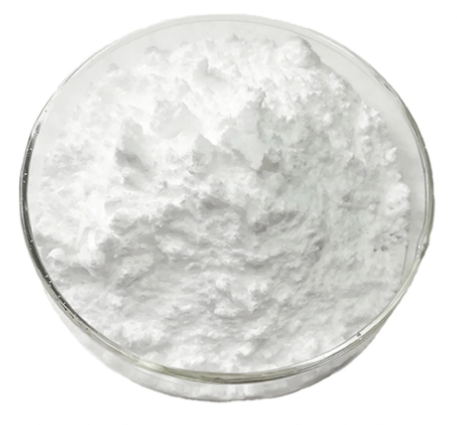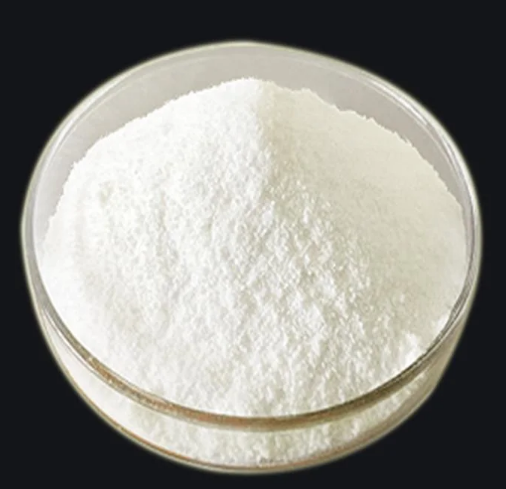-

CAPSO Na CAS:102601-34-3 Manufacturer Price
CAPSO Na, also known as 3-(cyclohexylamino)-2-hydroxy-1-propanesulfonic acid sodium salt, is a compound that belongs to the family of sulfonic acids. It is a zwitterionic buffer commonly used in various biochemical and molecular biology applications.
CAPSO Na acts as an effective pH-regulating agent and is widely used in buffer formulations to maintain a stable pH in a specific range. It has a pKa value of around 9.8 and is often employed in experiments that require a pH between 8.5 and 10.
The sodium salt form of CAPSO (CAPSO Na) enhances the solubility and ease of handling compared to the free acid form. It is water-soluble and readily forms stable solutions at different concentrations, making it convenient for various laboratory applications.
Some common applications of CAPSO Na include serving as a buffer in electrophoresis techniques, enzyme assays, protein purification, and cell culture media. Its buffering capacity and compatibility with biological systems contribute to its usefulness in these fields.
-

4-Nitrophenyl beta-D-galactopyranoside CAS:200422-18-0
4-Nitrophenyl beta-D-galactopyranoside (ONPG) is a chemical compound commonly used in enzymatic assays to detect the presence and activity of the enzyme β-galactosidase. It is a substrate for β-galactosidase, which cleaves the molecule to release a yellow product, o-nitrophenol. The color change can be measured spectrophotometrically, allowing for the quantitative determination of the enzyme’s activity. This compound is widely used in molecular biology and biochemistry research to quantify β-galactosidase activity and to study gene expression and regulation.
-

3-(cyclohexylamino)-2-hydroxy-1-propanesuhicic acid CAS:73463-39-5
3-(cyclohexylamino)-2-hydroxy-1-propanesuhicic acid is a chemical compound with the molecular formula C12H23NO3S. It belongs to a family of compounds known as sulfonic acids. This particular compound contains a cyclohexylamino group, a hydroxy group, and a propanesuhicic acid moiety. It is used in various industrial applications, including as a building block in organic synthesis and as a reagent in pharmaceutical research. The compound’s unique structure and properties make it suitable for specific chemical reactions and scientific investigations.
-
![Sodium 2-[(2-aminoethyl)amino]ethanesulphonate CAS:34730-59-1](https://cdn.globalso.com/xindaobiotech/图片943.png)
Sodium 2-[(2-aminoethyl)amino]ethanesulphonate CAS:34730-59-1
Sodium 2-[(2-aminoethyl)amino]ethanesulphonate is a chemical compound commonly known as taurine sodium. It is an organic compound consisting of a taurine molecule attached to a sodium atom. Taurine itself is a naturally occurring amino acid-like substance found in various animal tissues.
Taurine sodium is widely used as a dietary supplement and ingredient in functional beverages and energy drinks. It is known for its potential health benefits, such as supporting cardiovascular health, regulating electrolyte balance, and promoting cognitive function.
In the body, taurine sodium has roles in bile acid formation, osmoregulation, antioxidant activity, and modulation of neurotransmitter function. It is also believed to have anti-inflammatory properties and may help in the prevention of certain eye disorders.
-

MES sodium salt CAS:71119-23-8
MES sodium salt, also known as 2-(N-morpholino)ethanesulfonic acid sodium salt, is a chemical compound commonly used as a buffering agent. It is an acid with a pKa value of approximately 6.15. MES sodium salt is highly soluble in water and its effective buffering range is around pH 5.5 to 6.7. It is widely utilized in biochemical and biological research, as well as in various chemical reactions, protein purification, gel electrophoresis, enzyme studies, and cell culture experiments. The sodium salt form enhances the compound’s solubility and stability, making it easier to handle and use in laboratory settings.
-

Ada Monosodium CAS:7415-22-7
N-(2-Acetamido)iminodiacetic acid monosodium salt, also known as sodium iminodiacetate or sodium IDA, is a chemical compound commonly used as a chelating agent and buffering agent in various industries and scientific applications.
Its chemical structure consists of an iminodiacetic acid molecule with an acetamido functional group attached to one of the nitrogen atoms. The monosodium salt form of the compound provides improved solubility and stability in aqueous solutions.
As a chelating agent, sodium iminodiacetate has a high affinity for metal ions, particularly calcium, and can effectively sequester and bind them, preventing undesired reactions or interactions. This property makes it useful in a wide range of applications, including chemistry, biochemistry, pharmacology, and manufacturing processes.
In addition to its chelation capabilities, sodium iminodiacetate also acts as a buffering agent, helping to maintain the desired pH of a solution by resisting changes in acidity or alkalinity. This makes it valuable in various analytical techniques and biological experiments where precise pH control is necessary.
-

FLUORESCEIN MONO-BETA-D- GALACTOPYRANOSIDE CAS:102286-67-9
Fluorescein mono-beta-D-galactopyranoside, also known as FMG, is a fluorescent compound that is commonly used as a substrate in various biochemical and cell biology experiments. It is derived from methyl-beta-D-galactopyranoside by conjugating it with a fluorescein molecule.FMG is widely used to study the activity of beta-galactosidase, an enzyme that catalyzes the hydrolysis of lactose into galactose and glucose. By using FMG as a substrate, researchers can monitor the enzymatic activity of beta-galactosidase through the measurement of fluorescence emission. The hydrolysis of FMG by beta-galactosidase leads to the release of fluorescein, resulting in an increase in fluorescent signal that can be quantified.This compound is also utilized to investigate carbohydrate recognition and interactions. FMG can be used as a molecular probe to study the binding affinity of lectins (proteins that specifically bind to carbohydrates) to galactose-containing carbohydrates. The binding of FMG-lectin complexes can be detected and quantified based on changes in fluorescence emission.Overall, FMG is a versatile tool in studying enzyme activity and carbohydrate recognition, offering a convenient and sensitive method to measure fluorescence and evaluate these biological processes.
-

popso disodium CAS:108321-07-9
Piperazine-N,N’-bis(2-hydroxypropanesulphonic acid) disodium salt is a chemical compound composed of piperazine, bis(2-hydroxypropanesulphonic acid) groups, and two sodium ions. It is commonly used as a buffering agent and pH regulator in various industrial and laboratory applications. The compound helps maintain a specific pH in solutions, making it useful in processes such as protein purification, molecular biology, and pharmaceutical research. Additionally, it can also act as a chelating agent for metal ions and stabilize enzyme activity in certain biochemical reactions.
-

Heppso sodium CAS:89648-37-3 Manufacturer Price
N-[2-Hydroxyethyl]piperazine-N’-[2-hydroxypropanesulfonic acid] sodium salt is a chemical compound with the formula C8H19N2NaO4S. It is a sodium salt derived from piperazine, containing hydroxyethyl and hydroxypropanesulfonic acid functional groups. It is commonly used in the pharmaceutical industry as a buffering agent and stabilizer in formulations of drugs. This compound helps to maintain the pH and stability of medications.
-

CHES Na CAS:103-47-9 Manufacturer Price
2-(Cyclohexylamino)ethanesulfonic acid is a chemical compound with the molecular formula C10H21NO3S. It is also known by its abbreviation CHES. CHES is a sulfonic acid derivative that contains both an amino group and a sulfonic acid group in its structure.
CHES is commonly used as a buffering agent in biochemical and biological research. It is pH-stable and maintains a consistent pH environment, particularly in laboratory settings involving enzymatic reactions or protein studies. CHES has a pKa of 9.3, making it an effective buffer around pH 9.
Its unique chemical structure and properties make CHES useful in various applications, such as in the preparation of buffer solutions for electrophoresis, enzyme assays, and cell culture media. It is often preferred for applications that require a pH range of 8.5 to 10.
-

4-Nitrophenyl-alpha-D-galactopyranoside CAS:7493-95-0
4-Nitrophenyl-alpha-D-glucopyranoside is a chemical compound that is commonly used in biochemical experiments and assays. It is a substrate that can be cleaved by certain enzymes, such as glycosidases, to release a detectable product. Its structure consists of a glucose molecule (alpha-D-glucose) linked to a 4-nitrophenyl group. This compound is often used to study and measure the activity of enzymes involved in carbohydrate metabolism and glycosylation processes. Its yellow color allows for easy detection and quantification, making it a useful tool in various biochemical and enzymatic assays.
-

3-HYDROXY-4-(5-NITROPYRIDYLAZO)PROPYLANI CAS:143205-66-7
3-HYDROXY-4-(5-NITROPYRIDYLAZO)PROPANAL, also known as NBD-aldehyde, is a compound commonly used in biochemistry and molecular biology research.

